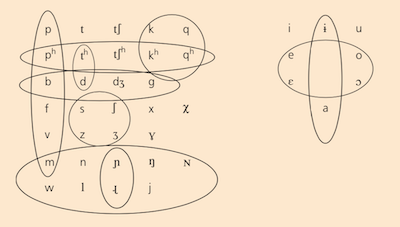USC Advanced Undergraduate Phonology ✳︎ Fall 2019 ✳︎ Smith
Rules, features, and abbreviations
The rules of the grammar operate in a mechanical fashion; one may think of them as instructions that might be given to a mindless robot, incapable of exercising any judgment or imagination in their application. Any ambiguity or inexplicitness in the statement of rules must in principle be eliminated, since the receiver of the instructions is assumed to be incapable of using intelligence to fill in gaps or to correct errors."
– Chomsky & Halle (1968: 60)
| Ø ➔ i / C_C |
| [+high] ➔ Ø / [–voice] _ [–voice] |
| [+consonantal] ➔ [–voice] / _ # |
| [–sonorant] ➔ [–voice] ∕ _ ]wd |
| C ➔ [+voice] / V _ V |
| [–sonorant] ➔ [–voice] ∕ [–voice] _ |
| k | æ | t |
|---|---|---|
| –syllabic | +syllabic | –syllabic |
| –long | –long | –long |
| +consonantal | –consonantal | +consonantal |
| –sonorant | +sonorant | –sonorant |
| –continuant | +continuant | –continuant |
| –delayed release | –delayed release | |
| –approximant | +approximant | –approximant |
| –tap | –tap | –tap |
| –trill | –trill | –trill |
| –nasal | –nasal | –nasal |
| –voice | +voice | –voice |
| –spread glottis | –spread glottis | –spread glottis |
| –constricted glottis | –constricted glottis | –constricted glottis |
| –labial | –labial | –labial |
| –round | –round | –round |
| –labiodental | –labiodental | –labiodental |
| –coronal | –coronal | +coronal |
| –lateral | –lateral | –lateral |
| +dorsal | –dorsal | –dorsal |
| +high | –high | |
| –low | +low | |
| … | … | … |
| sonorants | obstruents | |||||
| vowels | glides | liquids | nasals | fricatives | affricates | stops |
| [+syllabic] | [–syllabic] | |||||
| [–consonantal] | [+consonantal] | |||||
| [+approximant] | [–approximant] | |||||
| [+sonorant] | [–sonorant] | |||||
| [+continuant] | [–continuant] | [+continuant] | [–continuant] | |||
| (no value for [delayed release]) | [+delayed release] | [–del rel] | ||||
![One of the five vowel tensing rules from SPE (p. 242). [FB] and [seg] are features used for boundaries.](SPE_tensing_rule.png)

The top part of this rule expands into the sub-rules:
Let’s think about the predictions of this rule for the vowels below.
| Vowel | Tense | Low | Vowel | Tense | Low | |
|---|---|---|---|---|---|---|
| i | + | – | u | + | – | |
| ɪ | – | – | ʊ | – | – | |
| e | + | – | o | + | – | |
| ɛ | – | – | ɔ | + | + | |
| æ | – | + | ɑ | + | + |

[dental] isn't usually a feature, but is used here for simplicity. ↩